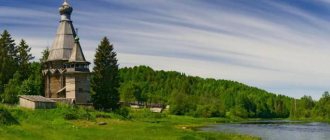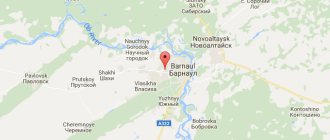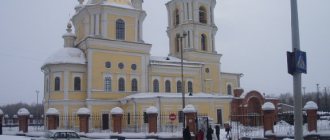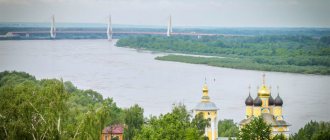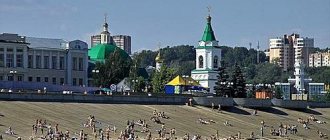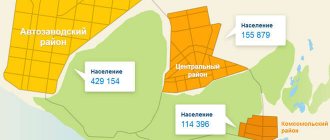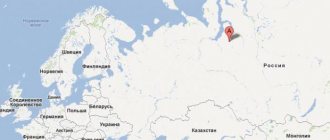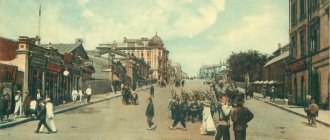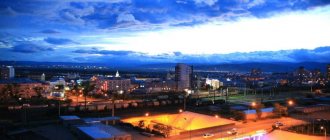“What region is Vladivostok?” Apparently, everyone who primarily deals with foreigners has heard such a question at least once in their life. Why? The thing is that Russia, as a rule, seems to them to be just a huge country occupying most of the continent - they are not used to dividing it into parts.
Although some citizens of our native country are also not particularly strong in geography, which means it’s time to answer the question: “Vladivostok - what region?” — to close it once and for all. Moreover, it’s probably just a shame not to know about such an amazing city.
Section 1. General description of the locality
Even for residents of Russia, the center of the Primorsky Territory, Vladivostok, seems to be, as they say, at the edge of the earth.
Indeed, if you look at it, everything here is completely different: the time, the terrain, the habits of the local residents, and even street advertising.
Although if you imagine where Vladivostok is, everything will actually fall into place. Initially, the city was built on the Muravyov-Amursky Peninsula, but over time its territory expanded to the islands of the Sea of Japan, located in a bay with a very symbolic name named after Peter the Great.
This city is very unique. It is often compared to San Francisco. All this thanks to the bridge built across the Golden Horn. Vladivostok is acquiring a futuristic image. Light Asian exoticism, represented by right-hand drive cars and a mixture of hieroglyphs and Cyrillic alphabet, is all commonplace for a city like Vladivostok (the region, by the way, is also no exception).
But, despite all this, the administrative center is a romantic settlement. The location of the city dictates its own conditions: at any time of the year, incredible, breathtaking, almost picturesque views open here. And from above, the city actually resembles Japanese prints or films about the city of the future.
“If the elections in the Khabarovsk Territory had ended differently, the idea would not have arisen” (about moving the center of the Far Eastern Federal District)
— Yuri Alekseevich, what is behind the transfer of the capital of the Far East from Khabarovsk to Vladivostok? Or is this nothing more than a pre-election move by Kozhemyako’s team? What will change when the plenipotentiary's office moves to us? And in general, according to the law, there is no capital in the Far Eastern Federal District - there is an administrative center. Khabarovsk, located closer to the geographical center of the region than Vladivostok, coped well with this role. Is there any concern that this step will permanently delay the adoption of another decision that you and your colleagues have been talking about for many years? I mean the transformation of Vladivostok into the Pacific capital of Russia, a city of federal significance.
— There is a fundamental misunderstanding of what the Far East is. This territory, after joining the Far Eastern Federal District of Transbaikalia, is comparable to Australia, and the population here is less than in Harbin. From Krasnoyarsk to the Pacific Ocean there is not a single million-plus city. The largest cities - Khabarovsk and Vladivostok - do not reach this level. Khabarovsk rightfully served as the center of the Far East, which is logical both geographically and historically.
Field, Russian field. Photo: PrimaMedia news agency
— And even since the time of the Governor General...
— And Vladivostok played a different role. Paradoxically, even during the period of closure, Vladivostok was more active than many other cities in the field of international relations. After its opening, foreign consulates and corporations immediately came here. All arguments justifying the transfer of the capital of the Far East to Vladivostok relate only to its international functions and have nothing to do with the Far Eastern region itself. At one time, Viktor Ishaev (in 1991-2009 - head of the Khabarovsk Territory, in 2009-2013 - presidential envoy to the Far Eastern Federal District - Ed.) held the Far Eastern Economic Forum in Khabarovsk, at which issues of economic development of the Far East were discussed. The Eastern Economic Forum in Vladivostok considers issues primarily of an international nature. It is significant that the Chinese consulate was initially located in Khabarovsk, but, realizing that all international life was in Vladivostok, it moved here.
— Historically, the Far East is bi-capital: part of the capital functions is performed by Khabarovsk, part by Vladivostok; Some district structures are located in the city on the Amur, others in the city by the sea.
- In the west there is a similar pair of cities - Moscow and St. Petersburg. Russia is so big that a similar decision is long overdue in the east of the country. Therefore, one of the priority infrastructure projects is a high-speed railway connection between Khabarovsk and Vladivostok, so that daily travel from one city to another becomes the norm.
I think this idea (about moving the center of the Far Eastern Federal District to Vladivostok. - Ed.) would not have arisen from Oleg Kozhemyako at all if the recent elections in the Khabarovsk Territory had ended differently. If Vyacheslav Shport (Khabarovsk governor in 2009–2018 - Ed.) had won, the question would have been simply inappropriate. But the unexpected victory of Sergei Furgal (LDPR candidate, governor of the Khabarovsk Territory since September 2021 - Ed.) became a reason to “punish” Khabarovsk, which Moscow agreed with. If we think about the interests of the Far East, then other solutions are needed.
Section 2. Geographical location
The entire Vladivostok district is located on the territory of the Muravyov-Amursky Peninsula, including the village of Trudovoye.
This territorial unit includes:
- Russian Island;
- Trudovoye village;
- Popov and Reineke islands;
- Beregovoe village.
There are plenty of advantages to this arrangement. First of all, it is impossible not to mention that the Golden Horn is an excellent bay for mooring ships. There are huge fishing and trading ports here. It follows from this that entrepreneurs involved in this business will never ask, speaking about Vladivostok: “Which region?”
The largest rivers in the region are the First and Second, Sedanka, Explanations and Bogataya.
The hill called the Eagle's Nest is the highest point of the city of Vladivostok, or rather its historical part; on the outskirts there are places even higher.
“The Amur region needs access to the sea” (about adjusting the borders of the Far Eastern regions)
— In November, at the Institute of Socio-Political Research of the Russian Academy of Sciences in Moscow, I proposed discussing the issue of the subjects of the Far East.
The area of the Khabarovsk Territory is about 800 thousand square meters. km. Its three northern districts make up more than half of the region, and only 10.5 thousand people live in them. From Khabarovsk to Okhotsk - 1600 km. How often do governors visit there?
The Chukotka Autonomous Okrug is equal in area to the Volga Federal District, which includes 14 federal subjects and four cities with a population of more than a million. In Chukotka there are barely 50 thousand people (in the city of Arsenyev there are more). Chukotka was once part of the Magadan region. It might be worth returning to this option. And if we add here the two northern districts of the Khabarovsk Territory - Ayano-Maisky and Okhotsky, we get 1.5 million square meters. km with a population of about 200 thousand people - the “Kolyma region” with the same natural conditions, a sparse population and a center in Magadan. This will make it possible to more effectively form the regional budget and develop all-weather modes of transport: helicopters, airplanes, ekranoplanes, airships, etc.
Another northern district of the Khabarovsk Territory - Tuguro-Chumikansky - logically fits into the territory of the Amur region, providing it with access to the sea. What are the hydraulic builders of the Zeya and Bureyskaya hydroelectric power stations doing today? But the project of a tidal power station in the area of the Shantar Islands remains relevant - an energy center that will allow the development of currently inaccessible territories. The north of the Far East is rich in deposits - this is our second Urals. But its development is hampered by a shortage of electricity. Changing the borders between the subjects opens up prospects for the Amur region, and gives a powerful impetus to economic development to the north of the Far East.
What is Khabarovsk Territory losing? Three northern regions. But it’s high time to include (or rather, return) the Jewish Autonomous Region. The EAO gains nothing from autonomy, while as part of the Khabarovsk Territory this territory has a chance.
— What do you think about the strange idea, given the transport gap, to unite Primorye and Sakhalin?
“There’s fish there, and there’s fish here” is a weak argument. So we can reach unification with Kamchatka... Vladimir Putin’s answer to the question of whether to annex Sakhalin to Primorye or not once again convinces me of the state’s uncertainty regarding the strategy in the east of the country. The President said that this was “an internal matter between the two regions.” But what comes first - government policy or the interests of private business or the population living here? If the feasibility of territorial transformations is justified not only by budgetary efficiency or military necessity, but also by an improvement in the socio-economic situation, then this needs to be explained to people. And when they are told: you decide for yourself... It is clear why the Sakhalin residents opposed the unification with Primorye: no one explained to them why this was.
Winter fishing championship on Sakhalin. Photo: PrimaMedia news agency
— Khabarovsk residents were against moving the center of the Far Eastern Federal District to Vladivostok, which is also understandable: this will hardly give anything to Vladivostok, and Khabarovsk is threatened with provincialization... It turns out that the state is eliminating itself, leaving the solution of such issues to commercial or political influence groups capable of orchestrating a regional a referendum in their own private interests? And by the way: what was the point in transferring Buryatia and the Trans-Baikal Territory from under the wing of the Siberian Federal District to the Far Eastern?
— For Acting Governor of Transbaikalia Alexander Osipov, former first deputy head of the Ministry of Eastern Development and one of the authors of the idea of priority development territories, it is important to receive the same preferential treatment to attract investors who operate in the Far East.
— What prevents you from simply extending the scope of priority development zones to Transbaikalia without changing the boundaries of federal districts?
— Nothing interferes; today the regime of priority development zones for some central regions of Russia is being discussed. In addition, let us remember that in many perspective documents Transbaikalia was considered together with the Far East.
Section 3. Climate Features
From a scientific point of view, Vladivostok is considered to have a monsoon climate. In practice this means the following:
- winter in the city and region is cool and dry, and the weather in the cold season is clear;
- spring is quite long, the temperature often changes;
- summers are humid and warm, this season accounts for the maximum amount of precipitation;
- autumn is warm, precipitation decreases towards winter, the first frosts generally appear in early November.
The warmest month in Vladivostok is August, temperature +20...+21 degrees Celsius. The coldest is January, temperature -11.3…– 11.5 degrees. The water temperature in August is +23 degrees, but only the most desperate and courageous dare to swim.
The average annual precipitation is 818 millimeters.
Vladivostok
Vladivostok is a city and port in the Russian Far East. Political, cultural and economic center of the region; administrative center of Primorsky Krai and Vladivostok urban district. Located on the Muravyov-Amursky Peninsula and islands in the Peter the Great Bay of the Sea of Japan.
The terminus of the Trans-Siberian Railway. One of the largest seaports in the Far Eastern basin. The main base of the Pacific Fleet. The largest scientific and educational center in the Far Eastern region, including the Far Eastern Federal University and the Far Eastern Branch of the Russian Academy of Sciences.
Founded as a military post "Vladivostok" in 1860, in 1880 it received the status of a city. Since 1888 - the administrative center of the Primorsky region, since 1938 - the Primorsky Territory.
Since October 12, 2015 - a free port (port zone enjoying special regimes of customs, tax, investment and related regulation).
Population - 606,653 people. (2016).
Physiographic characteristics
Geographical position
The Vladivostok urban district occupies the territory of the Muravyov-Amursky Peninsula up to and including the village of Trudovoye, the Peschany Peninsula, about 50 islands of the Peter the Great Bay (among which only 6 have an area of more than one square kilometer: Russky, Popova, Reineke, Ricorda, Shkota, Elena).
It stretches for a distance of about 30 km from south to north and almost 10 km from west to east (without the Peschany Peninsula), and is washed by the waters of the Amur and Ussuri bays, which are part of the Peter the Great Bay of the Sea of Japan. The urban district includes the city of Vladivostok, the village of Trudovoye, the villages on the islands of Russky, Popova, Reineke and the village of Beregovoe on the Peschany Peninsula.
According to data from the state land cadastre, as of January 1, 2005, the total area of land within the boundaries of the Vladivostok urban district is 56,154 hectares. The part of the district located on the Muravyov-Amursky Peninsula, including the village of Trudovoye, has an area of 35,044 hectares, and located on the Peschany Peninsula (with the adjacent territory) - 7,525 hectares. Russky Island, the largest of the islands included in the city district, has an area of 9,764 hectares. The area of the remaining islands totals 2915 hectares.
The river network is underdeveloped, highly regulated, and is represented mainly by small rivers and streams. The largest and most significant among them: Explanation, First River, Second River, Sedanka, Bogataya - all flow from east to west and, except for the Explanation River, flow into the Amur Bay. There are reservoirs on the Sedanka and Bogataya rivers.
The highest point in the historical part of the city is the Eagle's Nest hill, 199 m above sea level (according to other sources, 214 m). On the territory of the urban district, the highest point is considered to be an unnamed mountain with a height of 474 m, popularly called the Blue Sopka, located in the northern part of the Muravyov-Amursky Peninsula near the border with Artyom. Other significant heights are Mount Kholodilnik (257 m), Mount Russkikh (291 m), Mount Vargina (458 m). (see List of Vladivostok hills)
The shortest distance to Moscow on the surface of the Earth (at an altitude of 0 m above sea level) is 6430 kilometers, by rail - 9288 kilometers. Distance to other, closer cities: Seoul - 750 km, Tokyo - 1060 km, Hong Kong - 2820 km, Bangkok - 4400 km, Singapore - 5400 km, Darwin (Australia) - 6180 km.
Vladivostok, like the entire Primorsky Territory, is located in the Vladivostok time zone. The offset relative to UTC is +10:00. Relative to Moscow time, the time zone has a constant offset of +7 hours and is designated in Russia as MSK+7.
Time in Vladivostok is one hour ahead of geographic standard time.
Climate
The climate of Vladivostok is moderate monsoon. It is characterized by a clearly defined contrasting change in seasonal air masses. At the same time, the climatic conditions of the city are among the most favorable in the Russian Far East.
The winter period (November–March) is characterized by frosty, dry and clear weather, which is facilitated by the movement of dry cold air by the northern and northwestern winds of the winter monsoon. The average wind speed during this period is 6-9 m/s. There is little precipitation in the form of snow - 14-24 mm, and air humidity is 59-60%. In the first half of winter, heavy, often wet snow can fall, breaking trees.
In spring, southeast winds prevail with an average speed of 6.4 m/s. With high humidity, the weather remains cool. In late spring there are drizzles and fogs, the amount of precipitation is in the region of 7-26 mm.
The calendar summer in Vladivostok is divided into two clearly separated periods. The first half is characterized by cool and cloudy weather, with drizzling rain and fog. The second half is characterized by warm weather with prevailing south-easterly winds with an average speed of 5.3-5.8 m/s. In summer, typhoons with heavy rains are typical, when wind speeds increase 5-8 times, up to 20-35 m/s. Air humidity reaches a maximum of 87-91%. The climatic summer lasts from the end of June to the end of September.
In the first half of calendar autumn, warm, dry and sunny weather prevails. September is characterized by south-easterly winds, which in October-November are replaced by northerly winds. The amount of precipitation gradually decreases in winter. The first frosts usually occur in early November.
The average annual air temperature in the city is +4.9 °C. The warmest month is August, with a temperature of +19.8 °C, the coldest month is January -12.3 °C. The absolute maximum temperature of +33.6 °C was recorded on July 16, 1939 and July 17, 1958, the minimum of −31.4 °C was recorded on January 10, 1931. Water temperature in August and early September +21..+23 ° C (maximum +26.5 °C). Due to the complexity of the terrain, the sum of active air temperatures in the city area ranges from 2200 to 2800 °C.
The average annual precipitation is 840 mm. The record maximum daily precipitation of 243.5 mm occurred on July 13, 1989 (Typhoon Judy). The absolute maximum precipitation for the month, 403 mm, was recorded in July 2005. The average annual pressure is 763 mm Hg.
Flora and fauna
In the flora and fauna of the Vladivostok urban district you can find representatives of various natural complexes, since the city is located at the junction of several natural zones. The flora of the city, located in the southern subzone of mixed coniferous-deciduous forests, includes more than 1000 species of vascular plants: subtropical elements of the local flora make up 3% of the total number of species, the Manchurian oak forest complex accounts for up to 70%, the taiga - 13%, and local arctos -montane species - 1%.
Among the most common are Manchurian ash, Japanese elm, flat-leaved birch, common ash, black acacia, and viburnum-leaved uranium. In some places, ancient black fir forests have been preserved, but at present secondary forests predominate: oak-maple-linden, on the islands - oak-maple-birch, in river valleys - willow, elm and ash forests. Pine nuts, hazels, wild berries, mushrooms, ferns, wild garlic, and medicinal plants grow in the suburban forests.
In the plantings of the city there are rare species listed in the Red Book of Russia and the Red Book of the Primorsky Territory. Among them: calopanax seven-lobed, small-fruited alder, Ussuri pear, Manchurian apricot. Calopanax is represented in the natural plantings of Minny Gorodok Park and the alleys of Russkaya and Kirovskaya streets, Okeansky Prospekt. A unique grove of 700 small-fruited trees has been preserved in the Mine Town park. In the green spaces of parks and gardens you can find Sakhalin cherry and willow plum.
Of the birds within the city, at least 50 nesting species live, among them: pigeons, sparrows, black-tailed gulls, white-rumped swift, magpie, Kamchatka wagtail, white-bellied tit. Among the insectivores found in the forests are the Amur hedgehog, the Ussuri mole (mogera), the tundra shrew, the large-toothed shrew, and the great shrew. Among the bats recorded in the summer and on flights: bats, brown long-eared bats, leatherback bats, two-colored bats, tubebills. Of the lagomorphs - the bush hare. Rodents include flying squirrel, common squirrel, Asian chipmunk, field, forest and house mice, baby mouse, gray and black rats, muskrat, red-gray and Far Eastern voles. Predators include raccoon dog, fox, badger, weasel, weasel, and Far Eastern forest cat.
The coastal waters of Vladivostok are rich in marine animals. Here you can find: herring, smelt, navaga, flounder, greenling, rudd, pelengas, mussels, sea cucumbers, scallops, octopus and crabs.
Ecology
In the “Rating of Environmental Development of Russian Cities - 2014”, compiled by the Russian Ministry of Natural Resources, Vladivostok took 69th place among 94 participating cities. Previously, in 2013, Vladivostok took 45th place in this ranking among 85 participating cities.
In Vladivostok in 2014 there was an “ increased
» level of air pollution, nitrogen dioxide content is approximately twice the maximum permissible concentration (MPC). The unfavorable air condition is explained by the large number of vehicles. Parking cars on the roadway contributes to air pollution because it creates traffic jams. To a lesser extent, emissions from production facilities such as MUPV Special Plant No. 1 (waste incineration plant), CHPP-1, CHPP-2, etc. are affected.
For Vladivostok, washed by the sea on three sides, a big problem is the high pollution of the surrounding waters of the Amur and Ussuri Bays, the Eastern Bosphorus Strait and, especially, the Zolotoy Rog Bay, which in December 2013 a representative of Roshydromet declared the dirtiest water area in Russia.
Thus, according to a report on the environmental situation in the Primorsky Territory from 2014, the surface of the Zolotoy Rog Bay was covered with floating debris and an oil film by 91-100%. At the same time, the concentration of petroleum hydrocarbons in water has decreased and now exceeds the maximum permissible concentration by 1.5-2 times. The bioplankton living in the bay is poisonous, and eating fish caught here is dangerous. In 2015, the water quality in the Golden Horn improved to “moderately polluted”, and the average annual concentration of petroleum hydrocarbons decreased to 1 MPC.
Environmental measures
The main sources of pollution of sea waters near Vladivostok are industrial and sewage effluents from Vladivostok and other populated areas, as well as polluted waters of rivers flowing into the sea nearby. Historically, Vladivostok developed as a city without wastewater treatment facilities, in which almost all wastewater was directly discharged into the sea. In the 1990s–2000s, only 2% of the city's wastewater was treated.
During the preparation of Vladivostok for the APEC 2012 summit, three complexes of wastewater treatment facilities were built and the fourth was reconstructed.
As a result, the design capacity of treatment facilities increased to 380 thousand m³ per day (Northern treatment plants - 50 thousand m³ per day, Central - 160 thousand m³ per day, Southern - 160 thousand m³ per day, Treatment plants on Russky Island - 10 thousand m³ per day). In 2012, the governor of the Primorsky Territory, Vladimir Miklushevsky, announced a complete stop to the discharge of untreated wastewater into the sea. In fact, the largest, Southern wastewater treatment plants worth 9 billion rubles, although built, are not used at their designed capacity due to sewer collectors not connected to them. In 2013, only 30% of the city’s wastewater was treated; in 2021, about 85% was treated.
Section 4. Main attractions
Let's imagine once again where on a map or globe you can find Vladivostok (which region this is was indicated above). It is not surprising that so many different kinds of attractions are concentrated in this place.
- The Nikolaev triumphal gates were built at the end of the 19th century, in 1891. This decision was made by the Vladivostok City Duma in order to perpetuate the memory of the visit to Vladivostok by Nikolai Alexandrovich, the future Russian Emperor.
- St. Nicholas Cathedral was built in 1907. The church was erected in memory of the Russian soldiers who fell in the Russian-Japanese War (1904-1905).
- Oceanarium. The exhibition in this maritime museum is in honor of the nature of the Pacific Ocean. A huge variety of fauna of the seas, rivers and lakes of the Russian Far East.
- The Vladivostok funicular is the only one of its kind in the Russian Far East. Operating since 1962. The funicular route is from Sukhanov Street to Pushkinskaya Street. The journey is one and a half minutes.
